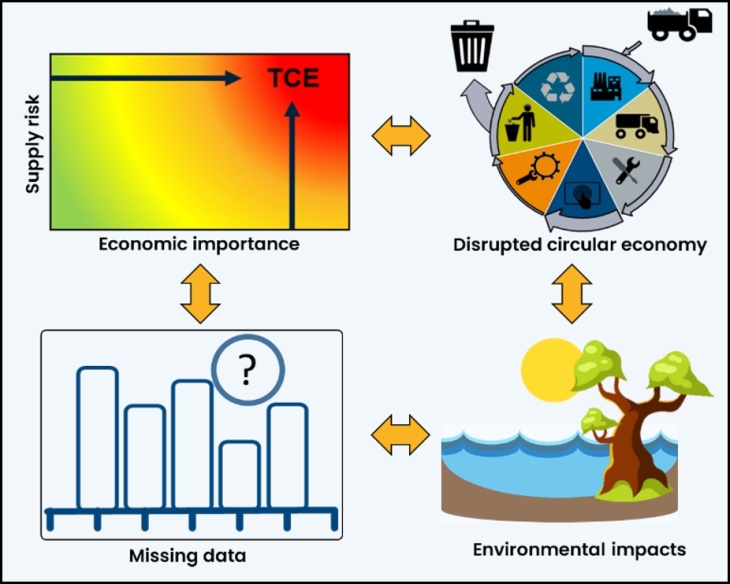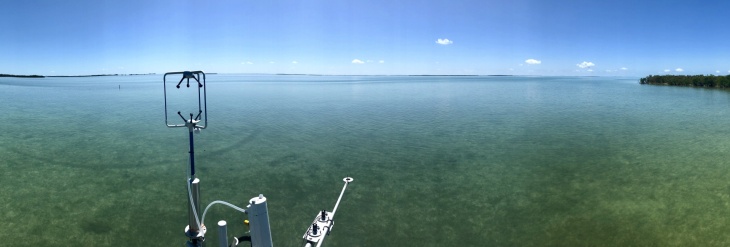Science Tools
Icebergs in water in a changing climate, Iceland (Photo: L.W. on Unsplash)
"Making better use of research findings can help transforming usable information into used knowledge."
Our Science Tools provide expert users with information on new methods and approaches, baseline assessments and re-evaluations of complex environmental problems including scenarios and projections for the land-to-sea continuum.
A tool for improving volatile organic compound emission factors in ship plumes
Integration of an aerosol-box model into a regional-scale chemistry transport model to indicate the changes in PM2.5 concentrations over the Mediterranean Sea based on VOC ship emissions.
International shipping contributes around 3% to 4% of global anthropogenic emissions through particulate matter emissions. Ships' emissions of volatile organic compounds (VOCs) can contribute significantly to the pollution of fine particles. Using an aerosol box model for the near-plume scale, this study studied how the altering VOC emission factor (EF) for ship engines influences the generation of secondary PM2.5 in ship exhaust plumes.
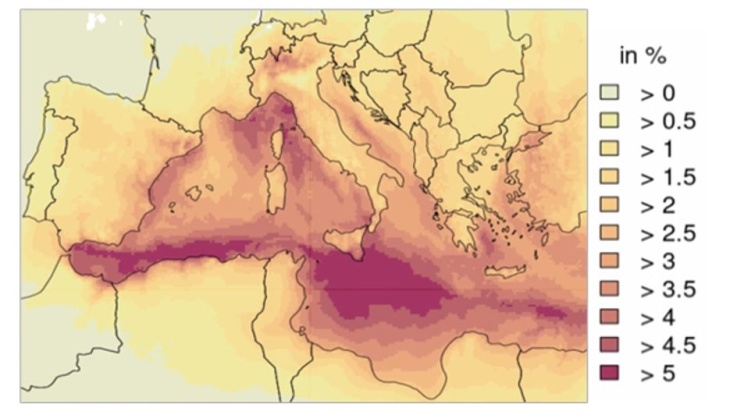
Changes in PM2.5 for the CTM run with adjusted ship emissions to initial ship emissions, displayed as mean values for June 2015
This tool development aims to analyze particle number and mass evolution in fresh ship plumes by using data from a measurement campaign focused on passenger ship emissions and by using the aerosol box model MAFOR. Measurement data was used to initialize the model run.
The simulated VOC EF was validated by performing several sensitivity runs with varying VOC EF to provide the most accurate approximation of observed particle size distribution data. The best-fitting approximation was utilized to correct VOC EFs in ship engines.
The scientists found the best estimation of real-world VOC EF when increasing the VOC EF in ship datasets with a factor 3.6. The MAFOR model output was integrated into the regional-scale chemistry transport model CMAQ via a change in the ship emission dataset with the updated VOC emission factor. The study found that adjustments of in VOC ship emissions had an impact on ambient PM2.5 concentrations with an increase of PM2.5 concentration of 5 % in areas with high shipping traffic (see figure).
This tool is of interest for researchers that are using small-scale models and focus on aerosol formation processes. Furthermore, this tool can help to improve the regional-scale model simulations by including the small-scale particle formation processes, that are often not considered in detail.
Fink, L.; Karl, M.; Matthias, V.; Weigelt, A.; Irjala, M.; Simonen, P. Using the Multicomponent Aerosol FORmation Model (MAFOR) to Determine Improved VOC Emission Factors in Ship Plumes. Toxics 2024, 12, 432. https:// doi.org/10.3390/toxics12060432
Access publication (external link)
An analytical method for the determination of pesticides in ambient air
More than 300 pesticides including transformation products can be analyzed in the particulate and gaseous phase of ambient air down to background concentrations in the low pg/m³ range.
Pesticides can be released into the atmosphere during spraying or after application due to various factors such as spray drift, volatilization, and wind erosion. They can then partition between the particulate and gaseous air phase and may affect areas beyond their intended target zones. Despite their essential role in crop protection, the widespread application of pesticides has raised multiple environmental and health concerns.

Picture by Kostik on iStock
This study describes the comparison of different extraction methods and the optimisation and validation of analytical methods for the determination of more than 300 pesticides in the particulate and gaseous phases of the air. Pesticides were collected with high-volume air samplers on glass-fibre filters (GFFs) and glass columns filled with polyurethane foam (PUF) and XAD-2 resin. In comparing different extraction methods, a QuEChERS extraction with acetonitrile proved to be the most effective for GFFs. For PUF/XAD-2 columns, a cold-column extraction with dichloromethane resulted in the best recovery rates and lowest standard deviations for the analytes. Instrumental analysis was performed using liquid chromatography/electrospray ionisation-time-of-flight mass spectrometry (LC/ESI-QTOF) and gas chromatography/electron impact ionisation-tandem mass spectrometry (GC/EI-MS/MS). Recovery rates between 70 and 120% were determined for 263 pesticides on the GFFs and 75 pesticides on the PUF/XAD-2 columns. Method quantification limits of the optimised methods ranged from 30 to 240 pg/m3 for the target compounds on the GFFs, and from 8 to 60 pg/m3 on the PUF/XAD-2 columns. To demonstrate the applicability of the method, environmental air samples from an agricultural region in the Netherlands were analysed. Pesticide concentrations in the air varied between 2 and 1390 pg/m³.

Comparison of relative recovery rates from different extraction methods for the extraction of GFFs. The different bars show the number of compounds detected with recovery rates below 30%, between 30 and 70%, between 70 and 120%, between 120 and 140% and above 140%. UAE = ultrasound-assisted extraction
This study uses novel extraction methods for the analysis of pesticides with a simultaneous detection and quantification of multiple pesticides in the particulate and gaseous air phase. By using time-of-flight mass spectrometry, the proposed methods are well-suited for suspect screening and non-target analysis, and can be further expanded to include additional further transformation products or analytes from other compound groups.
Debler, F., Gandrass, J. (2024): Development of an analytical method for the determination of more than 300 pesticides and metabolites in the particulate and gaseous phase of ambient air, Anal Bioanal Chem (2024), doi: 10.1007/s00216-024-05254-4
Access publication (external link)
A new model to calculate nitrogen fluxes and climate change impacts in the Szczecin Lagoon
Primary producers absorb a large proportion of the nitrogen input in the Szczecin Lagoon. In dry years, the retention capacity of the lagoon improves while the nitrogen assimilation increases due to internal nitrogen recycling.
Lagoons and estuaries belong to the land-ocean transition zone demonstrating high physical-biogeochemical gradients and complex interactions. This dynamic region is characterized by dramatic changes in both physical and biogeochemical properties, fostering complicated and multi-layered interactions with often uncertain consequences. The Oder estuary in the southern Baltic Sea comprises the Szczecin Lagoon, the Pomeranian Bay and a number of other shallow water areas and channels. The eutrophication of the Szczecin Lagoon, which is known for its abundance of fish, is an urgent issue for science and environmental management and represents a global problem.

In this study, paper titled "Eutrophication hotspots, nitrogen fluxes and climate impacts in estuarine ecosystems: A model study of the Odra estuary system", Helmholtz researcher Johannes Pein presents a new model that investigates the effects of nitrogen fluxes and the derivation of climate change impacts in the Szczecin Lagoon. The work carried out as part of the BMBF-funded "Blue Estuaries" (KüNO) project has not only ecological but also social significance. The new model framework developed at HEREON and adapted for the Oder region investigates the conversion of nitrogen loads from the Oder under the influence of interwoven, diverse biogeochemical processes.
The results show that the primary producers absorb a large proportion of the nitrogen input in the Szczecin Lagoon. Via so-called internal recycling, the amount of assimilated nitrogen can be even higher in a low runoff year, which improves the retention capacity of the Szczecin Lagoon. It is also shown how the ecosystem is likely to change as a result of projected anthropogenic climate change: With rising sea levels and higher mean water temperatures, the Szczecin Lagoon will become susceptible to oxygen depletion and reduce its retention capacity. For the adjacent Baltic Sea, this means an increase in eutrophying runoff from the Oder region with increased organic and inorganic nitrogen loads.
By understanding the interactions in river and marine ecosystems through studies like these, scientists can better assess how human activities affect coastal regions. This knowledge is important for the protection of coastal ecosystems and the sustainable use of their resources, which are the basis of life for many people. This research underscores the need to prioritize the protection and sustainable management of coastal ecosystems and to promote adaptation to climate change. By better understanding the complex relationships between humans and the environment, we can take action to strengthen the resilience of these ecosystems and ensure their long-term stability.
Pein, J., Staneva, J. Eutrophication hotspots, nitrogen fluxes and climate impacts in estuarine ecosystems (2024): A model study of the Odra estuary system. Ocean Dynamics 74, 335–354 (2024), doi: 10.1007/s10236-024-01607-w
Access publication (external link)
Contact: Johannes Pein, johannes.pein@hereon.de
How ecosystem states in the Elbe estuary evolved over the past 35 years
Significant shifts in dissolved inorganic carbon (DIC) and ecosystem state (1985–2020) in a temperate estuary driven by pollution (1980s), water quality improvement (after 1990), and climate change (drought of 2014-2020).

Map of the Elbe River and the estuary separated into seven zones and four regions, with sampling stations (black points) along the main shipping channel (light blue). Insert map: Schnackenburg station (474.5 Elbe-km, red filled circle) is located in the Elbe River. The tidal region is in dark blue, and the nontidal Elbe River in light blue. Figure was first published as Figure 1 in Rewrie et al. 2023a. Annual along-estuary dissolved inorganic carbon (DIC) patterns in the Elbe Estuary, with three distinct ecosystem states identified: Polluted, Transitional and Recovery states (Figure was first published in Rewrie et al. 2023a).
The Elbe Estuary underwent significant changes in its carbonate system since the 1980s, because of major pollution in the 1980s and prior, with heavy metal pollution exceeding the IKSE (Internationale Kommission zum Schutz der Elbe) levels identified as toxic for aquatic biota. Two studies, Rewrie et al. (2023a) and (2023b), acquired data for inorganic and organic carbon, and key ecosystem parameters from the data portal of the Flussgebietsgemeinschaft Elbe (FGG, River Basin Community; https://www.fgg-elbe.de/elbe-datenportal.html) for 1997 to 2020.
Using the long-term dataset, Rewrie et al. (2023a) identified three distinct ecosystem states, the Polluted (1985-1990), Transitional (1991-1996) and Recovery states (1997-2018). These states had distinctly and significantly different along-estuary patterns in ecosystem parameters, as illustrated by the annual along-estuary dissolved inorganic carbon (DIC) patterns (Figure left), and large seasonal fluctuations (Rewrie et al. 2023a). During the recovery state (1997-2018), DIC significantly increased by 11 μmol L-1 yr-1, and > 23 μmol L-1 yr-1 in the recent decade (2008–2018), in the mid to lower estuary.

Dissolved inorganic carbon lateral export (DIC) and particulate organic carbon (POC) loading in the Elbe Estuary, as well as the air water fluxes during 2 scenarios: 1) normal (non-drought) discharge and 2) drought conditions (2014-2020), based on data analysis (Figure originally published as graphical abstract in Rewrie et al., 2023b).
Rewrie et al. (2023b) investigated the underlying reasons for this increase (extending the record until 2020) and found a significant increase in particulate organic carbon (POC) concentrations in the upstream Elbe River regions (z1, Figure above). The POC increase was driven by improved water quality, and re-establishment of primary production in the Elbe River upstream of the Geesthacht Weir. This POC increase was on the same magnitude as the inorganic carbon produced in the estuary, suggesting the re-establishment of the Elbe Estuary as an efficient filter for organic carbon produced in the upstream Elbe River after 1997 (Figure above). Annually, the Elbe Estuary is a source of inorganic carbon to the atmosphere and to the coast. With 77 %–94 % of the total DIC export laterally transported to the coastal waters, reaching 89 ± 4.8 Gmol C yr−1, and only an estimated maximum of 23 % (10 Gmol C yr−1) released via carbon dioxide evasion between 1997 and 2020 (Figure right). More recently, the ecosystem is influenced by climate change, with an extreme flood (Voynova et al. 2017) and a prolonged drought (2014-2020) altering the carbon fluxes. While the air-water flux during drought and non-drought years, did not change (Figure right), the lateral DIC export from the estuary significantly decreased during drought years, on average by 24% (Figure right).
The evaluation of key ecosystem variables and inorganic and organic fluxes along a temperate estuary over the past four decades allowed for the identfication of the large-scale changes in ecosystem functioning, in relation to major anthropogenic interferences, from heavy metal pollution to water quality improvements to climate change extremes more recently.
Rewrie, LCV, YG Voynova, JEE van Beusekom, T Sanders, A Körtzinger, H Brix, G Ollesch, B Baschek (2022a): Nitrate Regeneration and Loss in the Central Yellow Sea Bottom Water Revealed by Nitrogen Isotopes, Frontiers in Marine Science, Vol. 9, (2022), doi: 10.3389/fmars.2022.834953
Access publication (external link)
Rewrie, LCV., Baschek, B., van Beusekom, J. E., Körtzinger, A., Ollesch, G., & Voynova, Y. G. (2023b): Recent inorganic carbon increase in a temperate estuary driven by water quality improvement and enhanced by droughts, Biogeosciences, 20(24), 4931-4947, doi:doi.org/10.5194/egusphere-2023-961
Access publication (external link)
Voynova, Y. G., Brix, H., Petersen, W., Weigelt-Krenz, S., & Scharfe, M. (2017): Extreme flood impact on estuarine and coastal biogeochemistry: the 2013 Elbe flood, Biogeosciences, 14(3), 541-557, doi: 10.5194/bg-14-541-2017
Access publication (external link)
A tool for more reliable estimates of shipping on air pollution with PM2.5 and inorganic particle species in coastal areas
A significant portion of emissions from the transport industry comes from ship movements. Exhaust particles have an impact on both local air quality and the chemical composition of the atmosphere. Maritime ship movements, particularly in coastal areas, make up a large part of the air pollution. Therefore, shipping has an impact on air quality and the deposition of pollutants and nutrients. The majority of particulate matter is secondary, which means it forms after emission in the atmosphere based on precursors and makes it difficult to simulate by chemistry transport models (CTMs).

Annual mean relative ship contributions for the model ensemble mean based on a five chemistry transport models for 2015
This tool development builds on the work and is the continuation of the presented Science Tool published earlier (see below) and the completion of the intercomparison study. Model simulations of regulated pollutants, whose concentrations should remain below specific threshold levels, were compared and the possible effects of ships on air pollution concentrations calculated. In this research, the Mediterranean Sea region was the point of interest. However, lessons from the model study can be applied to other coastal areas globally.
The scientists initially determined the model performance by comparing the model output with observed data using five CTMs. The setup is the same as for the previous tool, but the innovation of the present work was its focus on particulate matter. To obtain a reliable approximation and to avoid relying just on one model result, one ensemble model mean was estimated in a subsequent step. The main conclusions were that, first, all models often overestimate PM2.5 and second, that particulate matter output vary more among the CTMs compared to gaseous outputs (part I of the study). In all coastal regions of the considered domain, the Mediterranean Sea, the scientists found an impact of shipping on air pollution with 3 % to 15 % potential ship impacts on total PM2.5.
This tool is of interest for researchers using regional-scale models to see the range in which they can deliver results. Additionally, the tool of the ensemble mean can support decision- and policy-making when threshold levels should be based on a reliable estimate of air pollution.
Fink, L., Karl, M., Matthias, V., Oppo, S., Kranenburg, R., Kuenen, J., Jutterström, S., Moldanova, J., Majamäki, E., and Jalkanen, J.-P. (2023): A multimodel evaluation of the potential impact of shipping on particle species in the Mediterranean Sea, Atmos. Chem. Phys., 23, 10163–10189, doi: 10.5194/egusphere-2023-406
Access publication (external link)
Machine learning in marine ecology: an overview of techniques and applications
Machine learning (ML) covers a large set of algorithms that can be trained to identify patterns in data. Thanks to the increase in the amount of data and computing power available, it has become pervasive across scientific disciplines. The success of ML is associated with the increase in computational power over the last 20 years, but also with the increasing volume of available data, which led to the development of a broader diversity of algorithms, implemented in widely available software.
Scientists from many disciplines outside of computer science are now actively applying ML methods, and marine sciences are no exception. ML is promising in marine ecology for several reasons:
(i) Modern instruments produce large volumes of data that require scaling up their processing; the flexibility and adaptability of ML methods make them a natural choice for such automation.
(ii) This automation can also help to reduce the biases necessarily introduced by manual, hence improving reproducibility.
(iii) Finally, ML is adept at handling high degrees of uncertainty (i.e. dealing with noise in the data) associated with unknown underlying mechanisms or with non-stationary processes.

Treemap representation of the papers in the database that can be categorized according to the type of data they use. The area of each rectangle is proportional to the number of papers (written in brackets). The broad data types are bold and coloured with a given hue. Sub-types, when they exist, are in variations of the same hue.
For researchers whose expertise is outside of computer sciences, ensuring a proper application of ML methods and keeping track of new developments is challenging. The aim of the present review is to serve as a resource for marine ecologists who want to apply ML to their own data. To that effect, the section “A quick primer on machine learning” serves as a starting point for non-practitioners and introduces relevant vocabulary. The section “The setup of the database and its tags” describes our survey of the literature and the resulting structured database, on which the rest of the review is built. From it, we identified that ML is used at two stages in ecological research:
(i) to process the raw data collected and extract ecologically meaningful datasets from it and then
(ii) to combine these ecology-ready datasets together, and with others, to improve our understanding of ecological systems.

Machine learning methods used with satellite imagery data. Artifical neural networks (in blue shades), and, in particular, multi-layer perceptrons, dominate the literature that was reviewed.
Therefore, the section “Machine learning to extract ecological information from observational data” describes applications where ML was used to generate ecological datasets from various raw data types: images and video, optical spectra of single cells, acoustics, omics, geolocationrecords, and ocean colour imagery and biogeochemical profiles. The section “Machine learning to improve ecological understanding” describes how ML can be used to gain knowledge on the relationships between species and their environment (section “Predicting species abundance and distribution”), among species (section “Capturing dynamic ecological relationships”), and between us, humans, and marine ecosystems (sections “Summarizing ecosystems through regionalization” and “Supporting human decisions on ecosystem management”). Finally, the section “Discussion and perspectives” concludes on the commonalities among ML applications, suggests what is currently limiting them in ecology, and gives a general outlook of the field.
Rubbens, P., Brodie, S., Cordier, T., [...], Möller, K.O., et. al. (2023): Machine learning in marine ecology: an overview of techniques and applications. ICES Journal of Marine Science, 2023, 0, 1-25, doi: 10.1093/icesjms/fsad100
Access publication (external link)
Analysing potential metal emissions from offshore wind farms: An approach to support sustainable energy production in the marine environment
The expansion of the offshore wind sector is considered a crucial step towards carbon neutrality and renewable energy. However, the construction of every offshore structure, i.e. offshore wind farms or related infrastructure, interferes with the marine environment. The impact of potential chemical emissions through offshore wind farms is not well understood, even though it is known, that galvanic anodes, extensively used for corrosion protection of the offshore structures, emit metals continuously.

Mass fractions of the legacy pollutants Cd, Pb and Zn highlighted to be mostly within the known variability of North Sea sediments (Ebeling et al. 2023, Mar. Pollut. Bull. )
In this study, 215 surface sediment samples were collected in and around offshore wind farms (OWFs) in the German Bight during six sampling campaigns between 2016 and 2022. This study is the first to provide large-scale elemental mass fractions for sediments from OWFs in the North Sea and to discuss spatial and temporal trends. Previously suggested tracer elements Zn, Cd, Pb, In and Ga were analyzed together with Sr isotope ratios. Mass fractions of legacy pollutants Zn, Cd and Pb were mostly within the known variability of North Sea sediments. At the current stage, the analyzed mass fractions of the OWF specific tracers Ga, In and Ga/In ratios do not indicate accumulation in sediments caused by galvanic anodes used in OWFs.
However, galvanic anodes are per se a continuous source of metal emissions and thus are a new source of pollution within the marine environment. The results of this study are a starting point for a long-term monitoring of the tracer elements and the demonstrated approach can be adapted for other study areas to help better understanding and assessing effects of such chemical emissions on the marine environment. Furthermore, future OWF projects should also consider alternative corrosion protection techniques during their planning to reduce chemical emissions.
Ebeling, A., Wippermann, D., Zimmermann, T., Klein, O., Kirchgeorg, T., Weinberg, I., Hasenbein, S., Plaß, A., Pröfrock, D. (2023): Investigation of potential metal emissions from galvanic anodes in offshore wind farms into North Sea sediments. Mar. Pollut. Bull. 194, 115396, doi:10.1016/j.marpolbul.2023.115396
Access publication (external link)
An approach for an improved understanding of nutrient and carbon dynamics along the river-estuary-ocean continuum including extreme events
Nutrient and carbon dynamics within the river-estuary-coastal water systems are key processes in understanding the flux of matter from the terrestrial environment to the ocean. The longitudinal dynamics of carbon and nutrients as well as the quantity and quality of the transported material are highly dependent on hydrological conditions, particularly the dynamics of discharge. Discharge variability is likely to increase as hydrological extremes are projected to occur more frequently in future. To estimate the effect of hydrological extremes on riverine matter transport and processing, a focus on investigations during such events are needed, which cover the total spatial gradients from the river to the ocean. However, combined approaches measuring simultaneously in rivers, estuaries and coastal shelf regions are rare. The goal of the present study is a thorough understanding of the flux of carbon and nutrients from the land to the ocean, including the complex biogeochemical transformation processes within the water.
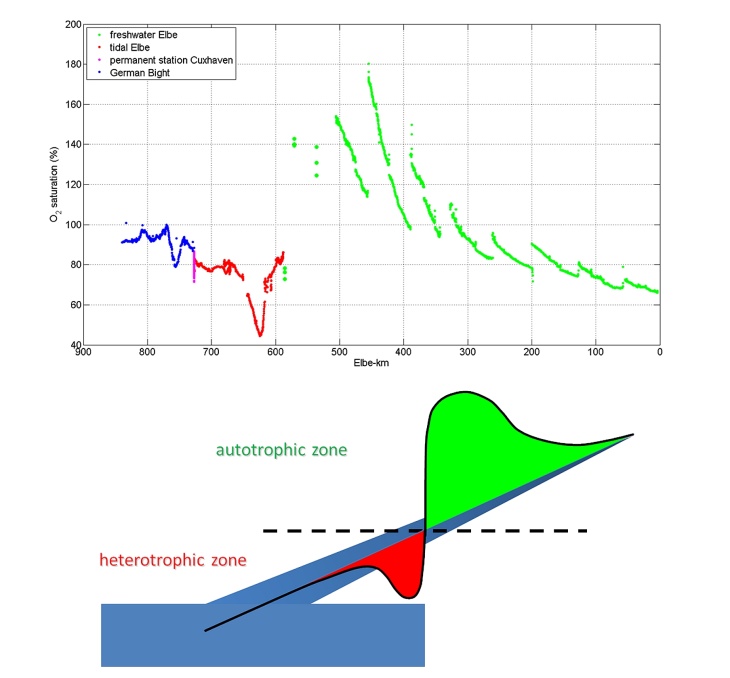
Upper panel: Longitudinal dynamics of oxygen saturation from upstream
(right) to downstream regions (left) in the freshwater river (green),
estuary (red) and coastal water (blue). Lower panel: Schematic pattern
auf autotrophic and heterotrophic zones (Kamjunke et al. 2023, STOTEN)
Here, the scientists analysed those dynamics by following a sampling approach based on the travel time of water and an advanced calculation of nutrient fluxes in the tidal part. The approach started with a nearly Lagrangian sampling of the river (River Elbe, Germany; 580 km within 8 days). After a subsequent investigation of the estuary, the scientists followed the plume of the river by raster sampling the German Bight (North Sea) using three ships simultaneously.
In the river, they detected intensive longitudinal growth of phytoplankton connected with high oxygen saturation and pH values and an undersaturation of CO2, whereas concentrations of dissolved nutrients declined. In the estuary, the Elbe shifted from an autotrophic to a heterotrophic system: Phytoplankton died off upstream of the salinity gradient, causing minima in oxygen saturation and pH, supersaturation of CO2, and a release of nutrients. In the shelf region, phytoplankton and nutrient concentrations were low, oxygen was close to saturation, and pH was within a typical marine range. Over all sections, oxygen saturation was positively related to pH and negatively to pCO2. Corresponding to the significant particulated nutrient flux via phytoplankton, flux rates of dissolved nutrients from river into estuary were low and determined by depleted concentrations. In contrast, fluxes from the estuary to the coastal waters were higher and the pattern was determined by tidal current. Overall, the approach is appropriate to better understand land-ocean fluxes, particularly to illuminate the importance of these fluxes under different seasonal and hydrological conditions, including flood and drought events.
Kamjunke, N.; Brix, H.; Flöser, G.; Bussmann, I.; Schütze, C.; Achterberg, E.P.; Ködel, U.; Fischer, P.; Rewrie, L.; Sanders, T.; Borchardt, D.; Weitere, M. (2023): Large-scale nutrient and carbon dynamics along the river-estuary-ocean continuum. Sci. Total Environ. 890 , art. 164421, doi: 10.1016/j.scitotenv.2023.164421
Access publication (external link)
Supporting standardisation of microplastics: A tool to monitor small microplastics using laser microdissection pressure catapulting
During the last decades, pollution with microplastics has become a global environmental threat. Legislators acknowledged this fact by implementation of different laws and guidelines, like the proposed restriction of intentionally added microplastics by the European Chemicals Agency (ECHA), or the California Safe Drinking Water Act (Senate Bill 1422) which specifically demands the development of standardized methods to monitor microplastics.

Setup of the LMPC instrument used to catapult PE and PET particles and PS microspheres into a collection drop (Hildebrandt et al. 2023, Anal. Bioanal. Chem)
Indeed, current analytical procedures lack the necessary standardization, which requires the usage of high-quality Reference materials (RMs). However, these materials do not yet exist (03/2023) for various reasons. Therefore, RMs for microplastic analysis are urgently needed. Techniques from other research fields such as laser microdissection pressure catapulting (LMPC) could help to solve this problem. LMPC uses two different analytical techniques commonly combined in one instrument: laser microdissection (LMD) and laser pressure catapulting (LPC). The technique enables cutting of different types of complex samples at the µm scale or even single cells (e.g. histological tissue) by means of a pulsed UV-A laser. Afterwards, the specimen of interest is selectively catapulted into a collection tube with a single UV-A laser shot.
The aim of this study was a proof of principle for the applicability of LMPC as an innovative new tool for the accurate handling and production of spike suspensions containing exact numbers of small microplastics (< 100 μm). The conducted experiments highlight the benefits of LMPC for future research related to the analysis and handling of microplastics. Experiments do not indicate any chemical or physical alteration of the studied model microplastic particles, which is a prerequisite for future in-depth studies. Possible applications can involve generation of urgently needed RMs, for particle number based analysis and method validation, spiking of internal standards, calibration of analytical instruments, or even the handling and sorting of environmental microplastic samples before further analysis. The method bears high potential for the generation of samples to be investigated in interlaboratory comparison studies or the accurate production of standard materials.
Hildebrandt, L.; Zimmermann, T.; Pröfrock, D. (2023): Laser microdissection pressure catapulting (LMPC): a new technique to handle single microplastic particles for number-based validation strategies, Anal. Bioanal. Chem., doi: 10.1007/s00216-023-04611-z
Access publication (external link)
A tool to estimate the potential impact of shipping emissions on air pollution in coastal areas
As global maritime transport volumes are projected to increase further in the future, significant share of emissions of air pollutants from shipping, such as NOx, must be considered. In this study, the authors focussed on a comparison of model simulations concerning the concentration of regulatory pollutants, which should stay under certain threshold levels and the calculation of potential ship impacts on air pollution concentrations. The study was part of theSCIPPER (Shipping contribution to Inland Pollution Push for the Enforcement of Regulations) project, which was carried out in several European regions and that - amongst others - focused on model studies. The present model study was carried out for the Mediterranean Sea region. Goal was to find tools to support decision-making towards regulations of shipping.

Relative potential ship impact on total NO2 and O3 concentration, simulated by each model (Model 1 to Model 5) and the calculated ensemble mean.
Using five chemistry transport models (CTMs), the scientists compared the model output with measured data in a first step to get an indication on the model performance. In a second step, they calculated one ensemble model mean to get a robust prediction and not only rely on one model output. Main findings were that all models usually underestimate nitrogen dioxide and overestimate ozone. In coastal regions of the considered domain of the Mediterranean Sea, the scientists found an impact of shipping on air pollution with 25 % to 45 % potential ship impacts on total NO2 and 3 % to 6 % potential ship impacts on O3.
The tool of the ensemble model mean with standard deviations based on different model results can give a more reliable estimate of potential ship impacts on the atmospheric concentration. Furthermore, this tool could indicate the limitations, over- and underestimations of model outputs of the used CTM systems. The study highlights the importance of the ensemble model mean especially in support of decision-making and regulation: If model simulations are expected to support decisions for shipping regulations, the uncertainty of single models must be considered.
Fink, L.; Karl, M., Matthias, V.; Oppo, S.; Kranenburg, R.; Kuenen, J.; Moldanova, J.; Jutterström, S.; Jalkanen, J.-P.; Majamäki, E. (2023): Potential impact of shipping on air pollution in the Mediterranean region – a multimodel evaluation: comparison of photooxidants NO2 and O3, Atmos. Chem. Phys., 23, 1825–1862.
Access publication (external link)
A statistical tool to assess long-term changes of trace element pattern in Wadden Sea surface sediments
The European Marine Strategy Framework Directive (MSFD) asks for good ecological status of the marine environment. This also includes the Wadden Sea as part of the North Sea, whose environmental condition is strongly influenced by the chemical status of its sediments. Within this context, our study analyzed the distribution of 42 elements in 32 Wadden Sea surface sediment samples, compared them with historical data and developed a multivariate statistical approach for data analysis.
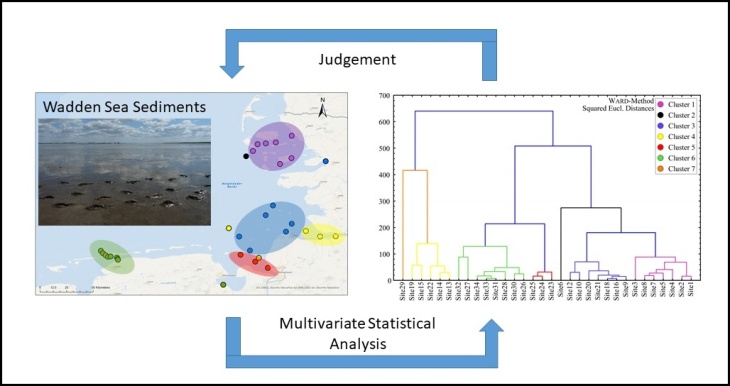
Map of the sampling locations (left) and color-coded areas (green, red, blue, yellow and purple) with similar elemental fingerprint based on statistical data analysis. Results of the statistical data analysis shown in right.
The comparison of recent (2014) with historical data (1984-1991) show that sediment quality significantly improved during the last decades. Indeed, some elements like Cd, Pb, Sn or Zn of today's Wadden Sea sediments are still elevated. The developed multivariate statistical data analysis approach, based on cluster and principle components analysis, is able to distinguish different geographical locations based on their elemental fingerprint and proved that these fingerprints are significant for the studied areas.
Based on these findings the authors conclude that only a few samples need to be taken in selected representative areas to assess the environmental condition of sediments. Therefore, future investigations only need to comprise and consider a reduced set of samples This makes environmental monitoring less time-consuming and more efficient.
von der Au, M.; Zimmermann, T.; Kleeberg, U.; von Tümpling W.; Pröfrock, D. (2022). Characteristic regional differences in trace element pattern of 2014 German North Sea surface Wadden sediments – A judge and assessment. Mar. Pollut. Bull. 184:114208, doi: 10.1016/j.marpolbul.2022.114208
Access publication (external link)
Combining FerryBox observations and CPT DriftApp simulations explain coastal ocean biogeochemical variability Link to referring CPT Drift App
Uptake of carbon dioxide in continental shelf seas is an important, but highly variable process. Using the high frequency data from a new FerryBox installation on a commercial ship, we were able to identify localised mesoscale events in the central North Sea, which had significant impact on the local CO2 ocean uptake. These mesoscale (10-100 km wide) events/features are short-lived (3-4 weeks), but they significantly decreased sea surface pCO2 and briefly counteracted the long-term increase in pCO2 in this region. Therefore, their influence on carbon uptake, albeit localized, is important in coastal oceans.
One particular low-pCO2 event occurred in the very dynamic region off the Danish coast, and was accompanied by decreases in sea surface temperature and salinity. This suggested that this event was driven by changes in the local water mass due to an advective process. Using the Drift App, available via the CPT's Management compartment, we were able to confirm that a sudden reversal of the usual circulation pattern off the northwest coast of Denmark caused the observed changes in surface temperature, salinity and pCO2.

FerryBox observations off the Danish coast identified decreased seawater pCO2, temperature and salinity in the second half of September 2019. Water mass movement simulations showed the different origin of the water masses reaching our observation site (Macovei et al., 2022, Front. Mar. Sci.)
Combined with the biologically-driven low pCO2 events identified in the following fall season, the carbon uptake capacity of the central North Sea was increased by these mesoscale features. We demonstrate the value of sustained biogeochemical observations and coupling them with physical models. These episodic mesoscale events are important and they should be considered in regional carbon budget assessments.
Macovei, V.A.; Callies, U..; Calil, P.H.R.; Voynova, Y.G. (2022). Mesoscale Advective and Biological Processes Alter Carbon Uptake Capacity in a Shelf Sea. Front. Mar. Sci. 9:827075, doi: 10.3389/fmars.2022.827075
Access publication (external link)
A biogeochemical tool to improve our understanding of the coastal ocean CO2 sink

Porewater irrigation ratesfor the North Sea only, derived from Ra budget (green) and incubations with Ra (orange) or bromide (blue) as tracers (Van Dam et al., 2022, Biogeosciences)
Shallow continental shelves are highly active regions of carbon burial, remineralization, and exchange, with net fluxes relevant to the global carbon cycle. Especially reactive are those with highly permeable sediments where currents and animals act together to rapidly flush surficial sediments with oxygenated water.
Our work used three independent approaches to assess this flushing rate and found that it is likely more rapid than previously thought. Importantly, this flushing delivers oxygenated water to the sediments. In the absence of this flushing, a suite of (mostly) anaerobic processes will produce alkalinity to the water column, which in turn will cause the net removal of atmospheric CO2.
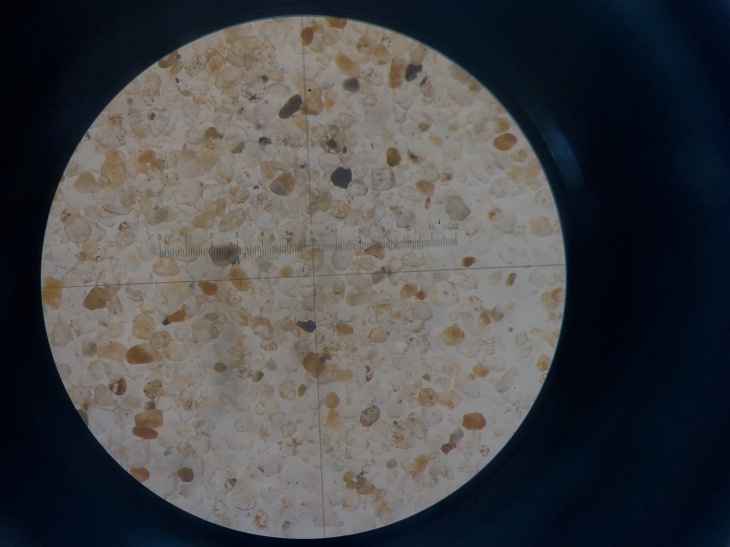
Sand grains collected from a German Bight sediment core taken during the HE541 cruise, as seen through a microscope (Van Dam et al., 2022, Biogeosciences)
The enhanced flushing that we observed effectively short-circuits these anaerobic processes occurring deeper in the sediments by balancing them with re-oxidation near the surface. The effect of this is a reduced flux of alkalinity from the sediments, thereby decreasing the capacity for surface waters to remove CO2 from the atmosphere.
Our understanding of the continental shelf carbon sink can be improved with better estimates of the seasonal and spatial variability in flushing rates and associated elemental fluxes.
Van Dam, B.; Lehmann, N.; Zeller, M. A.; Neumann, A.; Pröfrock, D.; Lipka, M.; Thomas, H.,; Böttcher, M.-E. (2022). Benthic alkalinity fluxes from coastal sediments of the Baltic and North seas: comparing approaches and identifying knowledge gaps. Biogeosciences, 19(16), 3775–3789, doi: 10.5194/bg-19-3775-2022.
Access publication (external link)
A novel technique to estimate in situ diatom growth rates by using the silica deposition fluorescent probe PDMPO
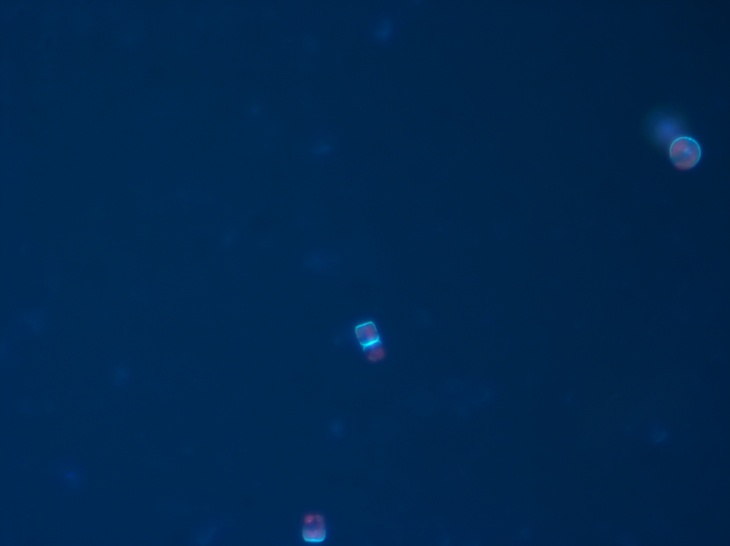
Fluorescent silica frustules under the microscope
Diatoms are the main contributors to primary production and drivers of the biogeochemical cycles of carbon, silicon and other major elements in the world’s oceans. Understanding their life cycle characteristics and species specific dynamics is crucial, however, impaired by poorly quantifiable processes such as mortality. PDMPO is a fluorophore that, when applied to growing diatom cultures, is incorporated only in newly polymerized silica in diatom frustules. Thereby it provides a tool to estimate silica uptake, study diatom cell cycles but also determine mortality-independent abundance-based species specific growth rates in cultures and natural assemblages.
In this study, the theoretical framework and applicability of the PDMPO staining technique to estimate diatom species specific growth rates have been investigated. The specific growth rate estimates based on the PDMPO staining patterns (μPDMPO) were comparable and more robust than growth rates estimated from the changes in cell concentrations (μcc).
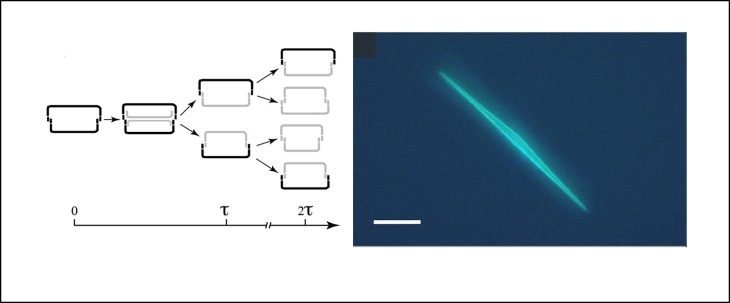
Diatom frustules are like a pill box casing. A new frustule is formed within the maternal cell during cell division. If PDMPO has been added only the newly formed silica frustules will fluoresce under the microscope
This method provides reliable and robust results within a short (24 h) incubation time frame: it is mortality independent, less variable than previous approaches and the short incubation time limits the impact of the so-called “bottle” effects. The proposed standard concentration of 0.125 μM PDMPO is sufficient to stain weakly silicified diatoms under replete nutrient conditions. However, even a higher concentration (up to 0.6 μM) does not significantly impair growth rates within a 24 h. The PDMPO technique provides a robust estimate of the species population growth rate as well as, depending on sampling strategy, information on the variability of growth rates within the population.
The understanding of the factors leading to diatom species specific dynamics and the resulting differential impact on vertical fluxes and transfer to higher trophic levels is however, still limited. By using the PDMPO method, a tool was developed that has the potential to provide a better understanding of the dynamics of phytoplankton in natural assemblages and their fate in biogeochemical cycles.
Husmann, E. and Klaas, C. (2022): Testing the use of the silica deposition fluorescent probe PDMPO to estimate in situ growth rates of diatoms. In: Limnology and Oceanography Methods. Early View, doi: 10.1002/lom3.10505.
Access publication (external link)
Baseline concentrations of technology-critical elements (TCEs) in North Sea sediments
Technology-critical elements (TCEs) are elements or minerals that bear a high supply risk, while also exhibiting high demand in the economy. They represent key components for today's high-tech industries and are therefore needed in almost every sector of modern economies. Consequently, the fields of application for TCEs range from energy production over entertainment electronics to the medical sector. Since the beginning of the 2000s, the application of TCEs has increased significantly and is expected to grow even faster within the next years. In this context, the disturbed and not fully closed circular economies of these elements play a decisive role, as this aspect leads to ever-rising waste flows, which might end up in the adjacent environmental compartments in the short or long run. Therefore, TCEs are gaining increasing attention in environmental research, as they show a high potential to enter the environment as new pollutants.
Despite the high interest to investigate the occurrence and fate of TCEs in the environment, the existing data for most TCEs are still too scarce to allow accurate assessments of their potential (eco-) toxicological effects. Moreover, the lack of considerable background or reference values hampers the distinct evaluation of TCEs and their role as potential uprising emerging contaminants.
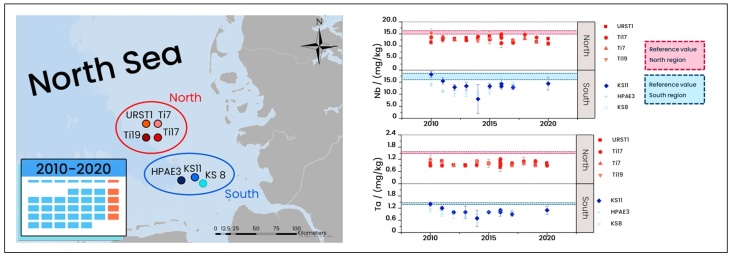
Map of the study area throughout the period from 2010 to 2020 (left); Mass fractions of the TCEs niobium (Nb) and tantalum (Ta) over the investigated period and the determined reference values (right)
Therefore, the occurrence and temporal variation of TCEs over ten years in the North Sea were investigated in this study. In cooperation with the German Federal Maritime and Hydrographic Agency, the BSH, Hereon researchers analyzed sediment samples, taken between 2010 and 2020 from BSH and Hereon, from two different coastal regions of the North Sea for their TCE content. Results reveal that for all investigated TCEs the temporal, as well as spatial variation, appeared to be minimal, implying no significant anthropogenic impacts yet. Consequently, determined mass fractions of this time series were used to estimate preliminary reference values for TCE contents in North Sea sediments.
As a result, these reference values provide a reliable starting point for future studies to better assess a possible pollution situation. Hence, a retrospective analysis of older samples and further statistical evaluation may be used to determine the factual background values of the TCEs or other analytes.
Klein, O.; Zimmermann, T.; Ebeling, A.; Kruse, M.; Kirchgeorg, T.; Pröfrock, D. (2022): Occurrence and Temporal Variation of Technology-Critical Elements in North Sea Sediments - A Determination of Preliminary Reference Values. In: Archives of Environmental Contamination and Toxicology, 82 (2022), doi: 10.1007/s00244-022-00929-4.
Access publication (external link)
Combining modeling approaches and modern stable isotope measurements: A tool to determine terrestrial nutrient inputs to support environmental planning in heavily populated coastal areas
Eutrophication is a worldwide problem in marginal seas that receive high loads of nutrients from anthropogenic sources. China, with its high population density and its fast-growing megacities along the coast, is facing increasing eutrophication pressure in its coastal waters. Thus, environmental and urban planners are challenged to find sustainable solutions for cleaner and healthier ecosystems in the marine environment.

Nitrate budget of the Bohai Sea, mass fluxes (mmol x 10 9) are complemented by respective nitrate isotope values (not shown for clarity). Arrow thickness corresponds to mass fluxes. Note that the largest input flux is nitrification, i.e., recycling of nitrate (modified after Tian et al., 2022b)
In two consecutive studies, an international team of researchers evaluated for the first time the sources of reactive nitrogen in the Bohai and the Southern Yellow Sea. This type of source is an important driver of eutrophication. A combination of modeling approaches and stable isotope measurements using state-of-the-art laboratory facilities was applied to provide for a reliable and comprehensive indication for eutrophication.
The approach showed that an amazingly large fraction of nitrate in the water column stems from microbial nutrient recycling and nitrate production in the water column. At present, this input outcompetes the capacity of regional coastal sediments to remove nitrate via respiration (summarized under the term ‘denitirification’).
The terrestrial inputs from the Changjiang River and the Yellow River have exhausted the capacity of the coastal ocean zones to remove and attenuate nitrogen. If nutrient inputs continue at present levels, the study regions are facing high ecological risky and may host low-oxygen environments in the coastal zone, which may lead to severe environmental problems. These hypoxic regions are spreading in the light of global change, and are threatening coastal aquatic ecosystems around the globe.
Tian, S.; Gaye, B.; Tang, J.; Luo, Y.; Lahajnar, N.; Dähnke, K.; Sanders, T.; Xiong, T.; Zhai, W.; Emeis, K.-C. (2022a): Nitrate Regeneration and Loss in the Central Yellow Sea Bottom Water Revealed by Nitrogen Isotopes. In: Frontiers in Marine Science, Vol. 9, (2022), doi: 10.3389/fmars.2022.834953.
Access publication (external link)
Tian, S.; Gaye, B.; Tang, J.; Luo, Y.; Li, W.; Lahajnar, N.; Dähnke, K.; Sanders, T.; Xiong, T.; Zhai, W.; Emeis, K. C. (2022b): A nitrate budget of the Bohai Sea based on an isotope mass balance model. In: Biogeosciences, Vol. 19, 2397-2415 (2022), doi: 10.5194/bg-19-2397-2022.
Access publication (external link)
Suspect screening: A powerful complementary tool to shed light on “dark matter” of per- and polyfluoroalkyl substances (PFAS) Photo slideshow on PFAS study
Per- and polyfluoroalkyl substances (PFAS) are a group of several thousand human-made chemicals that have been manufactured for more than seven decades. They are used in a broad range of consumer products and industrial applications, from fast food wrappers to firefighting foams. Due to their adverse effects on human health and the environment, some well-known PFAS have been globally banned. However, potential adverse properties, environmental occurrence and fate of next-generation PFAS remain largely unknown. Using traditional compound-specific analytical methods, so-called “target analysis”, only a small amount of PFAS on the global market is monitored.
In a new study, an international team of pollution researchers used high-resolution mass spectrometry (HRMS) to complement traditional target analysis and the total oxidizable precursor (TOP) assay as a sum parameter.

Results of target analysis, TOP assay and suspect screening as complementary analytical tools for a water sample collected in the German Alz River (Graphic by Hanna Joerss/Hereon)
Key findings
• Based on the developed suspect screening workflow, HRMS raw data was searched for 3.655 PFAS available on the global market.
• In German and Chinese river water samples, the suspect screening revealed 86 PFAS at different confidence levels. Only about 30 of them are routinely analysed in specialized labs.
• Eight substances were detected in the environment for the first time. This included C4 to C8 perfluoroalkyl dicarboxylic acids (PFdiCAs) and three perfluoroalkylether carboxylic acids (PFECAs) containing two ether bridges.
• The results indicated that a significant PFAS fraction had been missed by target analysis and TOP assay, particularly in samples taken downstream of fluoropolymer production sites.
• However, a comparison of the analytical tools also showed the limitations of HRMS-based approaches, for example the lower sensitivity compared to target analysis.
Conclusions
Even though five European member states are working on a restriction proposal addressing the entire group of PFAS within the framework of the European Green Deal, an analytical tool for measuring the “totality of PFAS” is not available yet. The present study underlines that the complementary use of suspect screening, target analysis and TOP assay can achieve a better coverage of “PFAS total“ compared to traditional stand-alone target analysis.
Original publication:
Joerss, H.; Menger, F.; Tang, J.; Ebinghaus, R.; Ahrens, L. (2022): Beyond the Tip of the Iceberg: Suspect Screening Reveals Point Source-Specific Patterns of Emerging and Novel Per- and Polyfluoroalkyl Substances in German and Chinese Rivers. In: Environmental Science and Technology, doi: 10.1021/acs.est.1c07987.
Access publication (external link)
Accumulated watershed sediments as pollution memories: A tool to identify peak pollution periods in deposited sediment layers to support industrial regulation

Occurence and decline of different pollution groups in the North Sea during the last century (Graphic: Logemann et al., 2022, Env. Pol.)
Especially during the last 100 years, a diverse cocktail of chemicals mainly from industrial sources, has been polluting the marine environment. Contaminants enter the ecosystem via rivers, the atmosphere and through direct sources. Due to prevailing currents in the sea, fine sediments are transported and accumulated strongly in distinct regions. Strong accumulation of sediments, to which pollutants preferably adhere, causes the seabed to grow by several millimetres per year. Sediments are called the memory of a watershed, as the varying exposure during different times is reflected in their deposited layers.
In a multi-partner study, pollution researchers used modern analytical equipment to identify periods of high pollution levels generating from changing industrial activities. As part of this comprehensive pollution fingerprint, sediment cores from North Sea’s main sedimentation area were taken, in the Skagerrak, where water depths cause high rates of deposition. The deep understanding of a pollution memory demonstrated that decreasing trends could be linked to the time of introductions of restrictions from regulation. Thus, the results highlight the effectiveness of environmental legislation by revealing a successive change in contamination levels over the decades. However, even after the early introduction of regulatory measures, long periods are required until pollutant concentrations return to their natural background levels.
Analysing sediment cores from the sea by using a fingerprint approach, can be promising to build up a pollution memory for the ocean in support of industrial regulation.
Logemann, A.; Reininghaus, M.; Schmidt, M.; Ebeling, A.; Zimmermann, T.; Wolschke, H.; Friedrich, J.; Brockmeyer, B.; Pröfrock, D.; Witt, G. (2022): Assessing the chemical anthropocene – Development of the legacy pollution fingerprint in the North Sea during the last century. In: Environmental Pollution, Vol. 302, 119040, (2022), doi: 10.1016/j.envpol.2022.119040.
Access publication (external link)
A tool based around a novel combination of methods reveals that tropical seagrasses are not a “miracle solution” to climate change Photo slideshow on tropical seagrass meadow experiment
Coastal management actions aimed at protecting or restoring seagrass meadows are often assumed to have the collateral benefit of removing large amounts of carbon dioxide from the atmosphere to combat climate change. Be aware, however: not all seagrass meadows are alike. Under certain conditions, some release more carbon dioxide than they absorb and are net carbon sources to the atmosphere. This is now shown in a new study by an international team of researchers, published in the scientific journal Science Advances. This study combined direct eddy covariance measurements of air-water gas exchange with geochemical approaches to build a comprehensive carbon budget for a tropical seagrass meadow in south Florida. The process of ecosystem calcification released far more CO2 to the atmosphere than was buried in sediments as “Blue Carbon.”
This study questions the reliability of Blue Carbon approaches towards net CO2 sequestration in tropical waters. But still unclear is how applicable these results are to the global scale, and what fraction of tropical seagrass meadows are net sources, rather than sinks, of CO2 to the atmosphere.f ethical rules is suggested as a way forward towards good governance in energy transitions.
Van Dam, B. R., Zeller, M. A., Lopes, C., Smyth, A.R., Böttcher, M. E., Osburn, L., Zimmerman, T., Pröfrock, D., Fourqurean, J. W., Thomas, H. (2021): Calcification-driven CO2 emissions exceed “Blue Carbon” sequestration in a carbonate seagrass meadow. Sci. Adv. 7, 1–10 (2021), doi: 10.1126/sciadv.abj1372.
Access publication (external link)
Sustainable energy transitions: An approach to examine stakeholder perception in supporting large off-shore infrastructure
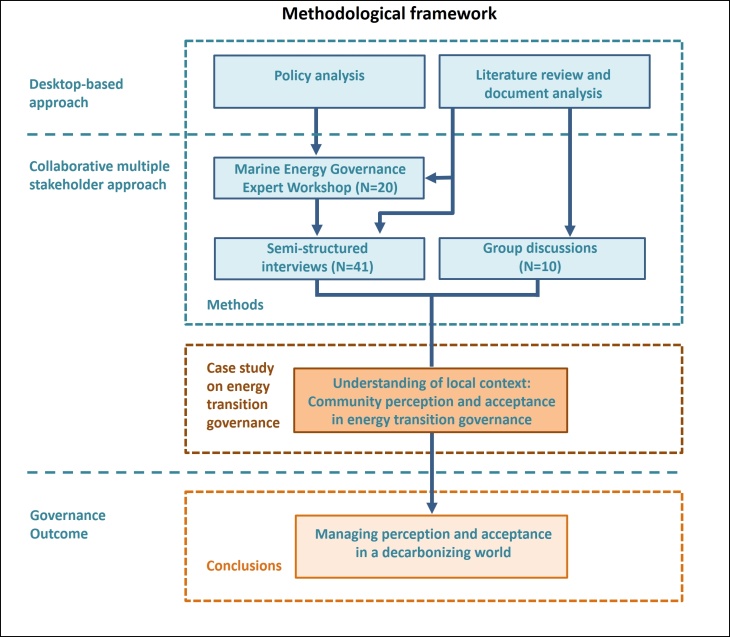
Methodological framework to assess stakeholder perceptions in a decarbonising world
In this study, Lange and Cummins (2021) investigated the enabling conditions for energy transitions at the community level and in coastal environments. The research was based on the study of a contested offshore gas field development in Ireland. In-depth analysis, as a tool to assess stakeholder perceptions, helped to identify causes of disputes in energy governance. The methodological framework covered an intense exchange with over 70 diverse stakeholders involved within semi-structured interviews, group discussions and a marine governance workshop, including a timeline development process.
The study shows that economic development is strongly linked to the cultural fabric, not just of the country, but of the locality. Here, a lack of trust of those in power had an influence on the conflict. The establishment of an honest broker with a mandate to evaluate the application of ethical rules is suggested as a way forward towards good governance in energy transitions.
Lange, M., Cummins, V. (2021): Managing stakeholder perception and engagement in a decarbonising world, Renewable and Sustainable Energy Reviews (2021), 111740, doi: 10.1016/j.rser.2021.111740.
Access publication (external link)
Application of emission modeling tools to assess air quality improvements during Corona lockdown Radio broadcast (in German) on Deutschlandfunk (with Dr. Volker Matthias, Hereon)
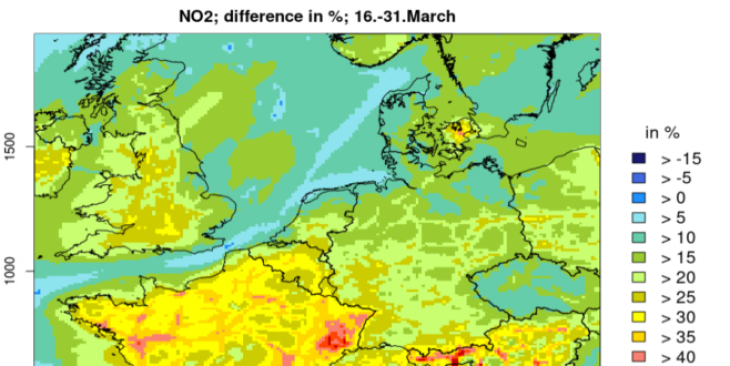
NO2 concentrations fell by more than half at many places in countries like France and Italy due to the strict lockdowns. Whereas in Germany the concentrations fell by only by up to 25 percent. Graphic: Volker Matthias et. al (2021).
In the study, Matthias et al. (2021) calculated the changes in air quality during the first lockdown based on scientific emission modelling tools. They also assessed to what extent weather conditions were responsible for the decreased emissions. The scientists found that the amount of nitrogen oxides dropped by more than half in some cases. In cities in particular, concentrations fell sharply. In addition to estimating pure emissions with and without lockdown, the calculations included weather conditions. The result shows that emissions from road traffic could be greatly reduced if significantly more people were able to work from home in the future.
Matthias, V., Quante, M., Arndt, J. A, Badeke, R., Fink, L., Petrik, R., Feldner, J., Schwarzkopf, D., Link, E.-M., Ramacher, M. O., Wedemann, R. (2021): The role of emission reductions and the meteorological situation for air quality improvements during the COVID-19 lockdown period in central Europe, J. Atmos. Chem. Phys., 21, 13931 – 13971, doi: 10.5194/acp-21-13931-2021.
Access publication (external link)
Extreme flood events: A drift-based tool enabling a synoptic assessment of spatially distributed observations based on drift simulations (see tool under 'Management Tools')
In the work from Callies et al. (2021), our scientists have used three examples to demonstrate the added value of using numerical drift models. Central objective was to validate and synthesize spatially and timely distributed observations. The method allows the identification of those measurements that belong to the same water body at different locations. By means of an exemplary application, using continuous observation data of the FerryBox on the ferry Büsum-Helgoland, the position of the freshwater tongue after the Elbe flood in June 2013 could be reconstructed into the Elbe estuary.
Callies, U., Kreus, M., Petersen, W., Voynova, Y.G. (2021): On Using Lagrangian Drift Simulations to Aid Interpretation of in situ Monitoring Data, Frontiers in Marine Science 8:666653, doi: 10.3389/fmars.2021.666653.
Access publication (external link)
In support of new SOPs - a new method for the assessment and analysis of microplastics developed
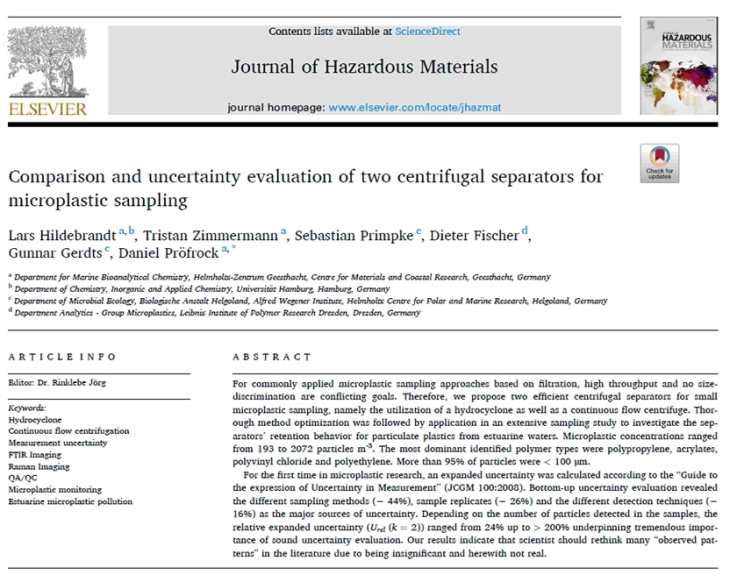
In this study, our scientists have detected high concentration of microplastic particles in the Elbe waterway as it passes into the North Sea. They have for the first time applied the important guideline for the collection of measurement uncertainties for the evaluation of the investigations. In this way, the results support the development of new Standard Operating Procedures in a focal area of pollution research in support of the toolbox.
Hildebrandt, L., Zimmermann, T., Primpke, S., Fischer, D., Gerdts, G., Pröfrock, D. (2021): Comparison and uncertainty evaluation of two centrifugal separators for microplastic sampling, Journal of Hazardous Materials, Volume 414, 2021, 125482, ISSN 0304-3894, doi.org/10.1016/j.jhazmat.2021.125482.
Access publication (external link)
Neural networks can reproduce results of complex chemical transport model calculations
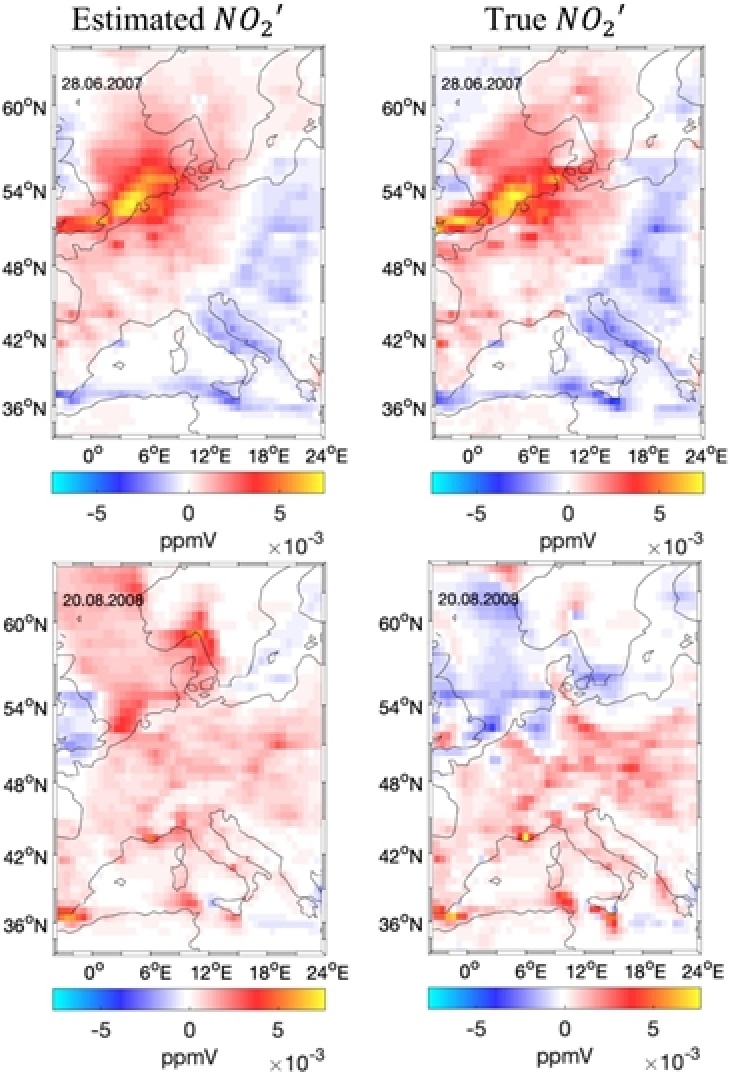
A neural network was created to replicate the calculation of air pollutant concentrations with complex models. This neural network "learned" based on several years of chemical transport model (CTM) simulations and was then able to calculate concentrations for other time periods very quickly. In the context of the toolbox development the research seeks to improve the scientific capacity of numerical modeling in support of assessing transport of atmospheric emissions.
Vlasenko, A., Matthias, V., Callies, U. (2021): Simulation of chemical transport model estimates by means of a neural network using meteorological data. Atmospheric Environment, https://doi.org/10.1016/j.atmosenv.2021.118236.
Access publication (external link)


